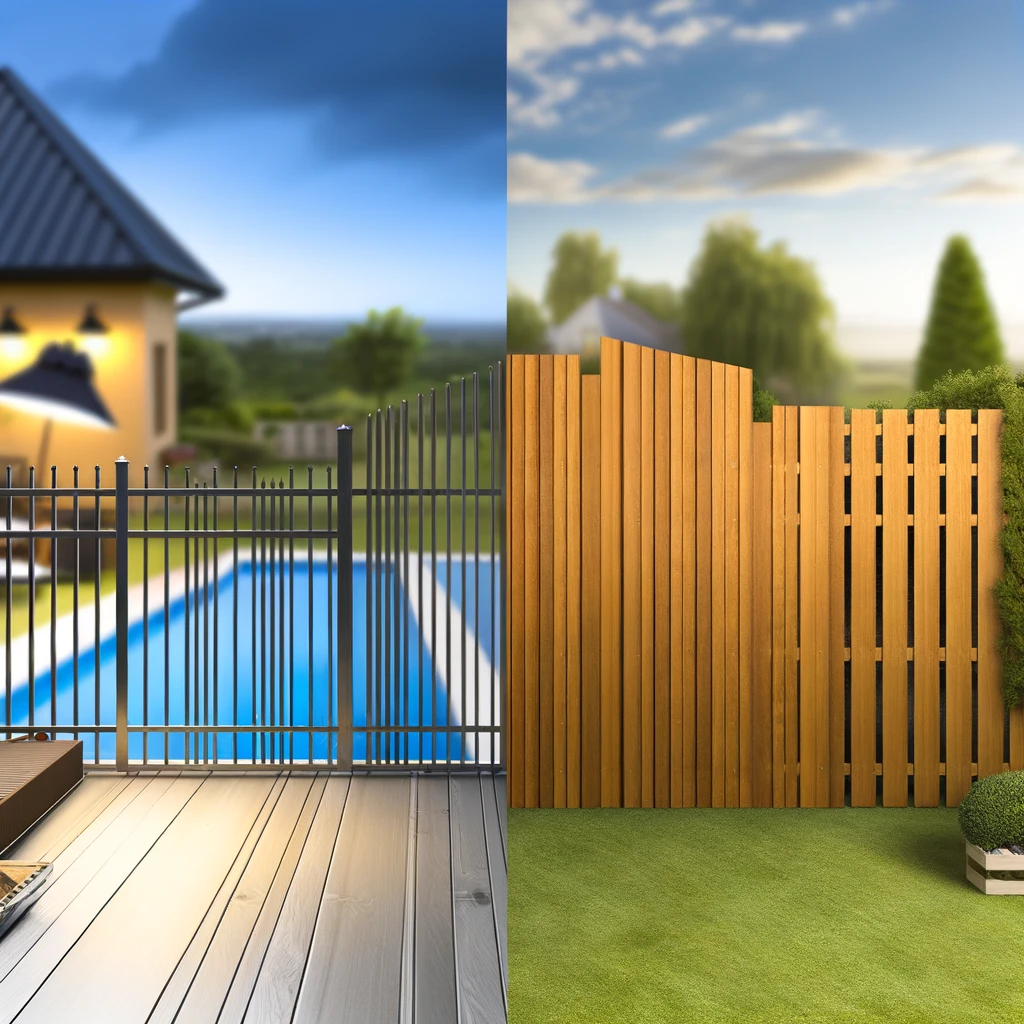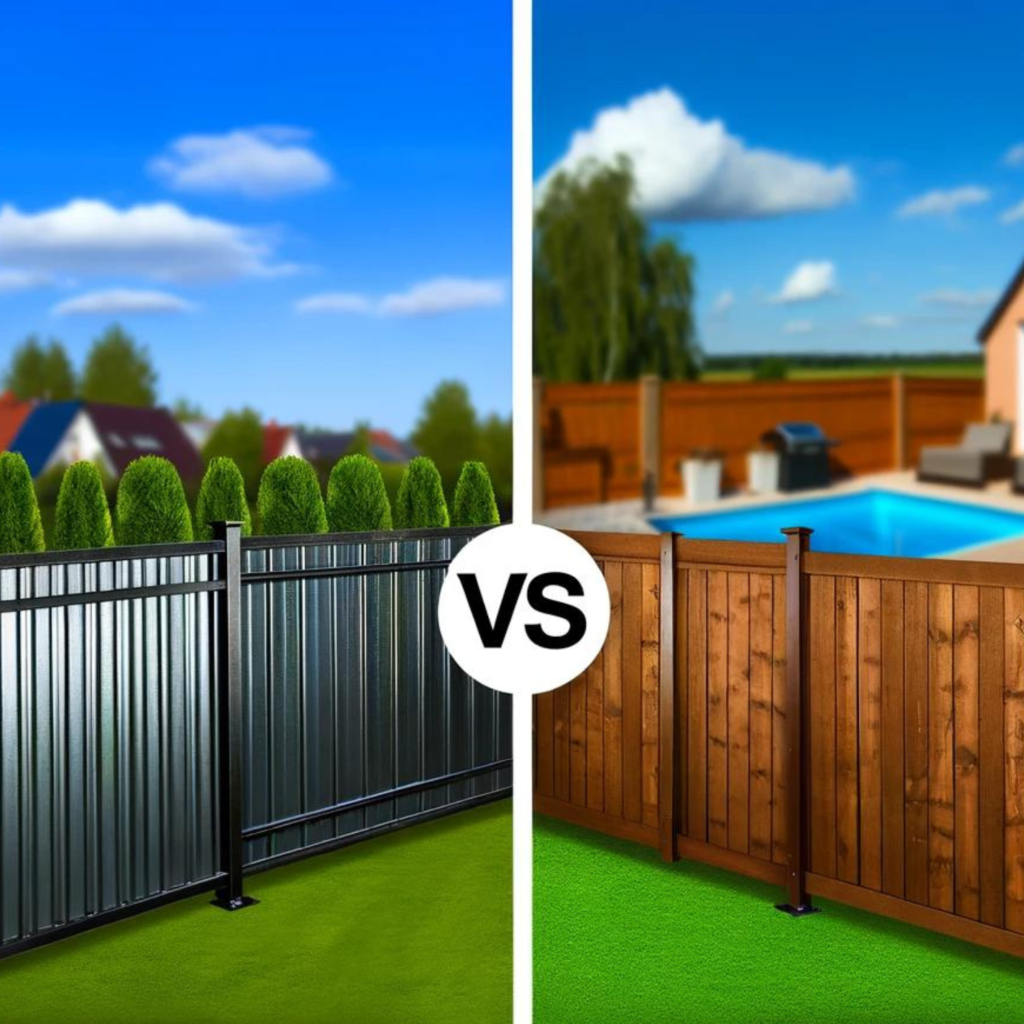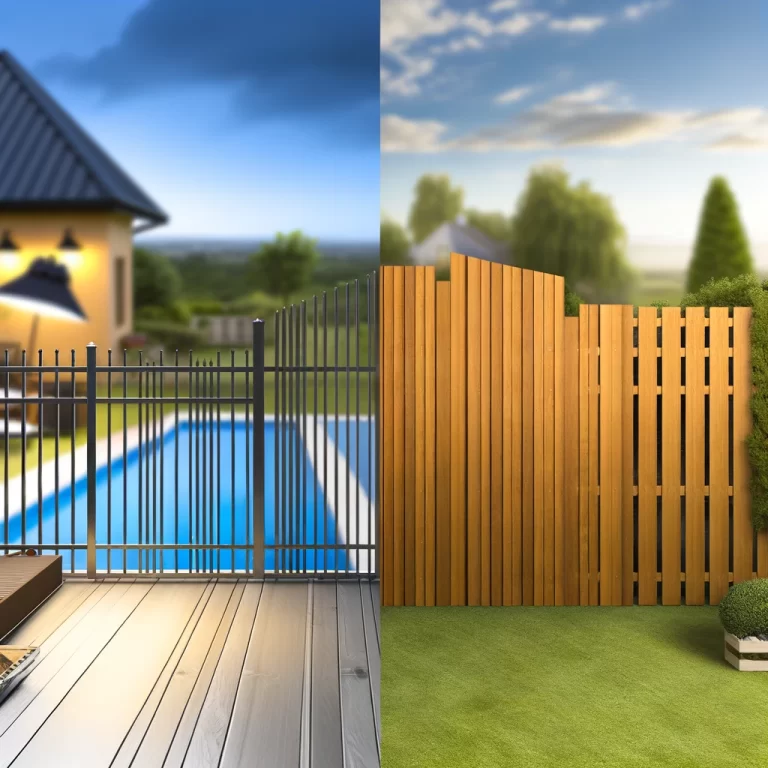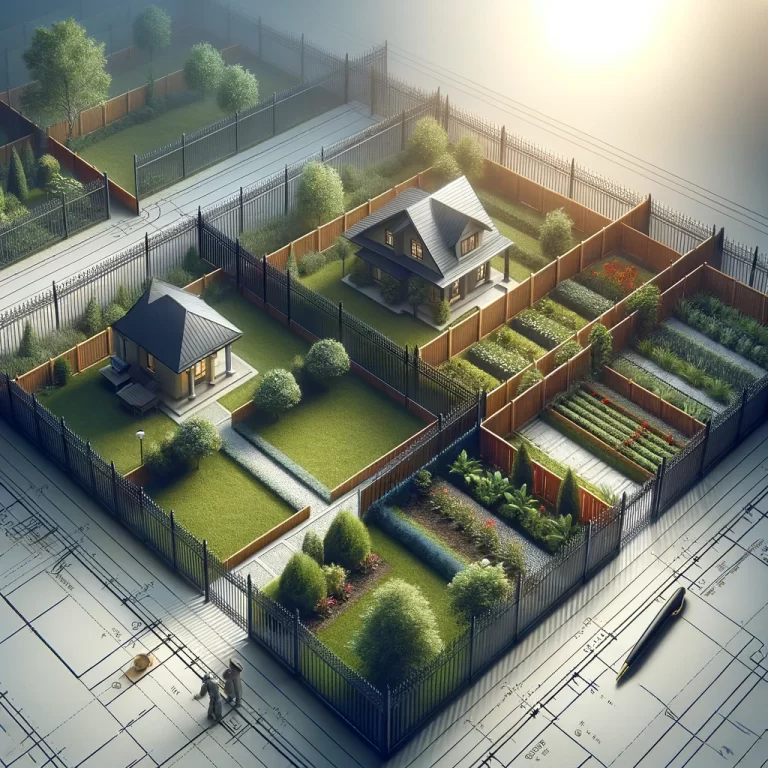Are you in the market for a new fence but unsure whether to go with metal or wood? This article will explore the different types of fences available, specifically focusing on metal and wood options. We will discuss factors to consider when choosing between the two, such as cost, durability, maintenance, aesthetic appeal, and security. We will compare the cost of both types of fences and weigh the pros and cons of each. Stay tuned to find out whether metal or wood fences are more expensive, and make an informed decision for your property.

Types of Fences
Regarding fencing options, there are various types available, including wood, metal, aluminium, steel, and ornamental iron.
Wood fences, known for their natural charm and versatility, are popular for creating a traditional, rustic look in residential settings. They can be stained or painted to match different aesthetics and offer privacy and security.
Metal fences, like wrought iron, exude elegance and strength, ideal for upscale homes or historic properties. Aluminium fences, on the other hand, are lightweight, durable, and require little maintenance, making them a practical choice for contemporary landscapes. Steel fences are robust and long-lasting, suitable for high-security areas or industrial applications. Ornamental iron fences combine decorative elements with durability, enhancing the kerb appeal of any property.
Metal Fences
Metal fences, such as those made of aluminium, steel, or galvanised steel, offer a robust security solution for residential and commercial properties.
Regarding security, these metal fences provide a strong physical barrier, effectively deterring intruders and enhancing the safety of the premises. Their durability ensures long-lasting protection against weather elements, corrosion, and wear, reducing the need for frequent repairs or replacements.
The low maintenance requirements of metal fences make them a practical choice for property owners. With simple cleaning and occasional inspections, metal fences maintain their appearance and efficacy over time, offering a reliable and cost-effective security solution.
Wood Fences
Wood fences, including traditional wooden fences, are popular for their timeless appeal, privacy features, and property enhancement capabilities.
One of the primary advantages of wood fences is their unparalleled design flexibility. With wood, homeowners can easily customise the look of their fence, choosing from various styles such as picket, lattice, or vertical board. Wood fences can be painted or stained in a range of colors to match the overall aesthetic of the property, offering a level of customisation that other fencing materials may not provide.
Factors to Consider When Choosing Between Metal and Wood Fences
Choosing between metal and wooden fences involves considering factors such as cost, maintenance requirements, durability, and installation complexity.
Regarding cost, metal fencing usually has a higher initial expense than wood, but it often requires less maintenance in the long term, potentially balancing out the initial investment. Conversely, wooden fencing may need more regular upkeep, such as staining or painting, to prevent weathering and rot.
Concerning longevity, metal fences are recognized for their durability and can outlast many wooden varieties, especially when properly coated to resist corrosion. Wooden fences can offer a charming, natural aesthetic that some homeowners find attractive compared to the industrial look of metal fences.
Cost
Regarding cost, metal fences typically have a higher upfront investment compared to wood fences, depending on the property size and installation requirements.
While metal fencing might incur a higher initial cost, it offers significant benefits in terms of durability and maintenance. Metal fences are known for their longevity and resistance to elements, requiring minimal upkeep over the years. On the other hand, wood fences may demand more frequent maintenance such as staining or painting to prevent decay.
When considering long-term savings, metal fences often outpace wood fences due to their extended lifespan and reduced maintenance expenses. Property owners can potentially save on repairs and replacements, making metal fencing a cost-effective investment in the long run.
Durability
Durability is a crucial factor to consider, with metal fences often being maintenance-free and offering a longer lifespan compared to wooden counterparts.
Whilst metal fences can withstand harsh weather conditions without requiring frequent upkeep, wooden fences are more susceptible to rotting, warping, and insect damage over time, necessitating regular maintenance to prolong their lifespan.
On the other hand, opting for metal can provide a long-term solution with minimal maintenance needs, ensuring an elegant and sturdy perimeter for your property. Metal fences offer a wide range of design options, from ornate styles to sleek modern designs, blending durability with aesthetic appeal.
Maintenance
Maintenance requirements vary between metal and wood fences, with metal fences often benefitting from powder-coated finishes that reduce upkeep needs compared to wooden options.
Regarding maintaining metal fences, regular inspections for signs of corrosion or damage are crucial to prevent rust and ensure the fence’s structural integrity. Cleaning with a mild detergent and water can help maintain the powder coating and remove any debris that could cause deterioration over time.
On the other hand, wooden fences require more frequent upkeep tasks such as staining or sealing to protect the wood from moisture, rot, and pests. Without proper maintenance, wood fences are susceptible to warping, cracking, and fading due to exposure to the elements.
While the upfront cost of a metal fence with powder coating may be higher than a wood fence, the long-term maintenance costs are often lower, making it a more cost-effective option in the grand scheme of things.
Aesthetic Appeal
Considering the aesthetic appeal, both metal and wood fences offer distinctive design options, with metal fences like ornamental iron providing elegant and decorative choices.
On one hand, metal fences convey a sleek and modern look, often featuring intricate scrollwork or geometric patterns that add a touch of sophistication to any property. On the other hand, wood fences exude a warm and natural charm, with variations such as picket, split rail, or lattice designs creating a welcoming and traditional feel. Regarding decorative possibilities, both metal and wood fences can be customised with embellishments like finials, post caps, or decorative panels to elevate their visual appeal.
Security
Security is paramount, and metal fences are often preferred for their strength and reliability in safeguarding properties, particularly in areas like Austin.
Regarding enhancing property protection, metal fences offer unparalleled durability against intruders and provide a robust physical barrier. Their strong and sturdy construction acts as a formidable deterrent, making them ideal for locations requiring high-level security measures. Unlike wood fences, metal fences are resistant to rot, fire, and pests, ensuring long-term security benefits with minimal maintenance.
Metal fences can be customised with various security features such as spikes, anti-climb designs, and electronic access control systems, further fortifying the security perimeter of a property. In comparison, while wood fences may offer a more traditional look, they often lack the same level of security enhancements as metal fences.

Cost Comparison between Metal and Wood Fences
A detailed cost comparison between metal and wood fences involves analyzing factors like initial costs, long-term expenses, and additional costs related to each fencing type.
When considering initial costs, metal fences tend to be pricier upfront due to the higher cost of materials and installation. They require minimal maintenance, reducing long-term expenses. On the other hand, wood fences are more affordable initially, but ongoing upkeep like staining, painting, and repairs can add up over time.
Additional costs, such as customisation options, gate installations, and permits, vary for each type of fencing. Metal fences offer versatility in design but may incur higher customisation charges, while wood fences might require more frequent treatments, impacting supplementary expenses.
Initial Cost
The initial cost of installing metal fences in Austin may be higher than that of wood fences due to the material and installation complexities involved.
When considering the upfront costs, it is essential to take into account the average material costs for metal and wood fences in the Austin area. Metal fences tend to be more expensive due to the higher quality of materials required, such as wrought iron or aluminium. On the other hand, wood fences can vary in cost depending on the type of wood chosen, with cedar being a popular option for its durability and aesthetic appeal.
Along with material costs, the installation complexities for metal fences, like welding and precise measurements, often contribute to the overall expense. Wood fences, although less labour-intensive to install, may still incur costs for professional installation to ensure durability and longevity.
Long-term Cost
When evaluating long-term costs, metal fences may offer savings due to their durability and lower maintenance requirements compared to wood fences over time.
One significant advantage of metal fences is their exceptional durability, as they are resistant to rot, pests, and extreme weather conditions, which can lead to long-lasting performance and reduced repair or replacement needs. In contrast, wood fences are more prone to decay, insect infestations, and warping, requiring regular upkeep and potential replacements over the years.
The maintenance costs associated with metal fences are typically lower than those of wood fences since they do not require staining, painting, or sealing to maintain their appearance and structural integrity.
Additional Costs
Beyond the initial and long-term costs, additional expenses such as property adaptations and specialised installation may impact the overall investment in metal or wood fences.
When considering metal fences, it is essential to account for potential property modifications that might be required to accommodate the heavier material. This could involve reinforcing the foundation or ensuring proper support structures are in place, adding to the overall project expense. On the other hand, wood fences, while typically lighter, may also necessitate adjustments depending on the terrain and landscape, leading to additional costs.
The complexity of installation can vary depending on the fence material chosen. Metal fences often require specialised tools and skills due to their durability and strength, leading to higher labour costs. Conversely, wood fences may demand more intricate techniques for proper installation, potentially requiring more time and effort from the installers.
Additional charges might arise during the installation process, such as fees for hauling away old materials, disposal of waste, or permits required for certain types of fences. These supplementary costs should be factored into the overall budget to ensure a comprehensive assessment of the investment in a metal or wood fence.
Pros and Cons of Metal Fences
Metal fences, particularly those made of galvanised steel, offer advantages such as enhanced security features, but they also come with considerations like potential maintenance needs.
Galvanised steel possesses a high level of durability, making it an ideal material for fencing that needs to withstand various weather conditions and potential impacts.
The strength of metal fences adds an extra layer of security to properties, deterring intruders and ensuring peace of mind for homeowners.
On the downside, regular maintenance like inspections for rust or corrosion is essential to maintain the fence’s integrity over time. Metal fences can be susceptible to scratching or denting, requiring occasional repairs.
Pros
The pros of metal fences include superior security capabilities, elegant design options like ornamental iron, and long-lasting durability for property protection.
Metal fences are renowned for their ability to provide a strong and secure perimeter for both residential and commercial properties. The sturdy construction of metal fencing offers a high level of protection, deterring trespassers and enhancing privacy for the property owners. Ornamental iron fences stand out for their classic and sophisticated appearance, adding a touch of elegance to any property. The durability of metal fences ensures that they can withstand harsh weather conditions, offering a long-term fencing solution that requires minimal maintenance.
Cons
Despite their strengths, metal fences may have drawbacks such as higher initial costs, maintenance requirements for powder-coated finishes, and limited privacy compared to wood alternatives.
- Metal fences generally require more upfront investment compared to other fencing materials like wood or vinyl. The initial cost of purchasing the materials and installation can be a barrier for some homeowners.
- Maintaining the appearance of metal fences can be demanding, especially when they have powder-coated finishes. Regular cleaning, repainting, or refinishing might be necessary to prevent corrosion and keep the fence looking good over time.
- Privacy can be a concern with metal fences, as their design often features open patterns that allow visibility through the fence. This can be a drawback for those seeking a higher level of seclusion and security on their property.
Pros and Cons of Wood Fences
Wood fences, including traditional wooden options, offer benefits like natural aesthetics, privacy features, and customisation possibilities, but they may require regular maintenance for longevity.
Regarding privacy, wood fences can be a top contender, especially in residential neighborhoods where creating a secluded outdoor space is key. The solid construction of wood panels provides a barrier that keeps prying eyes at bay. The warmth and charm that wood fencing exudes complement various architectural styles, blending effortlessly with both traditional and modern homes.
On the downside, the issue of maintenance surfaces – wooden fences need periodic staining, sealing, and repair to withstand the elements and prevent rotting. This ongoing upkeep can be time-consuming and add to the overall cost of owning a wood fence.
Pros
The pros of wood fences encompass privacy benefits, property enhancement through natural aesthetics, and the versatility to customise designs according to individual preferences.
Wood fences are renowned for their ability to provide a sense of seclusion and security to homeowners, making them an ideal choice for creating intimate outdoor spaces. The natural beauty of wood can complement any property, adding a warm and inviting touch to the landscape. What sets wood fences apart is the flexibility they offer in terms of design options, allowing for unique configurations that suit specific style preferences.
Cons
Wood fences may present challenges such as durability issues in harsh weather conditions, ongoing maintenance demands, and potential susceptibility to rot over time compared to metal alternatives.
Wooden fencing, albeit charming and rustic, tends to require more attention and care to maintain its appearance and structural integrity. When exposed to intense sunlight or heavy rain, wooden fences are more prone to warping, fading, and needing regular refinishing.
Ongoing maintenance tasks such as staining, sealing, and treating the wood can be time-consuming and costly in the long run, compared to the more low-maintenance nature of metal fencing options.
Wood fences are susceptible to damage from pests, such as termites or rot caused by moisture exposure, which can compromise their stability and lifespan, making them less durable than their metal counterparts.
Which is More Expensive: Metal or Wood Fences?
Determining whether metal or wood fences are more expensive involves evaluating various factors, including material costs, maintenance expenses, and long-term investments.
Regarding material costs, metal fences are typically pricier upfront than wood fences. The cost of materials for metal fencing, such as aluminium or wrought iron, can be higher per linear foot compared to wood options like cedar or pine. Additionally, wood fences require more frequent maintenance, including staining or painting, which can add to the overall long-term expense. On the other hand, metal fences are generally more durable and may require less maintenance over time, potentially offsetting the initial higher cost with fewer upkeep expenses.
Conclusion
When deciding between metal and wood fences for your property in Austin, consider factors like cost, durability, maintenance needs, aesthetic preferences, and security requirements to make the best choice.
Regarding cost, wood fences are generally more budget-friendly initially, although they may require more maintenance over time compared to metal fences, which are typically more expensive upfront but have lower long-term maintenance costs.
The durability aspect is another crucial factor to ponder over. While metal fences are known for their resilience and strength against various weather conditions, wood fences can be prone to rotting, warping, and pest infestations if not properly treated and maintained.
Regarding maintenance needs, metal fences are often considered low-maintenance, requiring occasional cleaning and rust prevention. On the contrary, wood fences may need regular staining, painting, and repairs to keep them looking their best and protected from decay.
Design preferences also play a key role in deciding between metal and wood fences. Metal fences offer a sleek, modern aesthetic and can be customised in various styles, while wood fences provide a classic, rustic charm that blends well with natural surroundings.
Security requirements should not be overlooked. Metal fences are usually more effective at enhancing security and privacy due to their sturdy construction, whereas wood fences may offer less obstruction but can still provide a certain level of protection.







